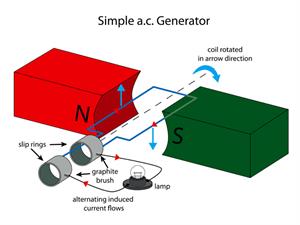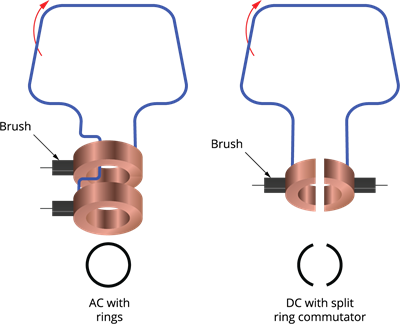PDF chapter test TRY NOW
Any machine that converts mechanical energy to electricity for transmission and distribution over power lines to domestic, commercial, and industrial customers is known as an electric generator, also known as a dynamo. Automobiles, aircraft, ships, and trains all use electricity generated by generators.
A rotating rectangular coil ABCD called armature is placed between the two poles of a permanent magnet in an alternating current (AC) generator. The coil's two ends are attached to two slip rings, S1 and S2. These rings are insulated on the inside. S1 and S2, two conducting stationary brushes B1 and B2, are kept separately on the rings. Internally, the two rings S1 and S2 are connected to an axle. To rotate the coil inside the magnetic field, the axle can be mechanically rotated from the outside. The two brushes' outer ends are connected to the external circuit.

Alternating current generator
The magnetic flux associated with the coil changes as the coil is rotated. Induced current will be generated as a result of the change in magnetic flux. According to Fleming's Right-hand rule, the induced current flows along ABCD in the coil and from B2 to B1 in the outer circuit. The direction of current in the coil during the second half of rotation is along DCBA, and it flows from B1 to B2 in the outer circuit. For every half-rotation of the coil, the induced current in the external circuit changes its direction.
A split ring type commutator must be used to obtain a direct current. One brush is in contact with the arm moving up in the field at all times, while the other is in contact with the arm moving down. As a result, a unidirectional current is created. As a result, the generator is referred to as a DC generator.

Comparison of AC generator and DC generator
